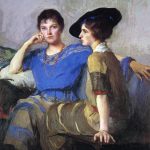
Leon Wyczółkowski was a prominent Polish painter and a key figure in the late 19th and early 20th-century art scene in Poland. He was born on April 11, 1852, in Huta Miastowska, a small village in what is now Poland. He came from a modest background, but his talent for art was evident from a young age.
Wyczółkowski’s early artistic education began in Warsaw, where he studied at the School of Fine Arts under the guidance of renowned Polish painter Wojciech Gerson. He later continued his studies in Munich and Paris, which were major centers of art and culture during that time. These experiences exposed him to various artistic styles and influences, shaping his own artistic vision.

Throughout his career, Wyczółkowski’s work evolved through several phases. In his early years, he primarily painted historical and genre scenes, often with a focus on Polish folklore and traditions. However, it was his later shift towards Impressionism that would define much of his legacy. Inspired by French Impressionists like Claude Monet and Pierre-Auguste Renoir, Wyczółkowski embraced a more modern and experimental approach to painting, capturing the play of light and color in his works.
One of Wyczółkowski’s most famous paintings is “The Spring” (1904), a masterpiece that reflects his Impressionistic style. This painting, featuring a young girl with a wreath of flowers, remains an iconic symbol of Polish art.
A Deep Artist
Apart from his Impressionist works, Wyczółkowski was also known for his portraits, landscapes, and scenes depicting everyday life. His portraits, in particular, are notable for their psychological depth and sensitivity, revealing the inner character of his subjects.

Leon Wyczółkowski was not only a prolific painter but also an active member of the Polish artistic community. He played a significant role in the promotion of Polish art and culture, contributing to the development of the Polish modern art movement. He was a co-founder of the Society of Polish Artists “Sztuka,” an organization that aimed to unite and support Polish artists during a crucial period in the country’s history.

Wyczółkowski’s dedication to his craft and his contributions to the Polish art world earned him numerous accolades and awards during his lifetime. He was also a respected teacher, sharing his knowledge and passion for art with the next generation of Polish artists.
Leon Wyczółkowski passed away on December 27, 1936, in Warsaw, leaving behind a rich legacy in Polish art. His paintings continue to be celebrated for their beauty, innovation, and the profound impact they had on the development of modern Polish art. Today, his works can be found in museums and galleries across Poland and are treasured by art enthusiasts around the world.







